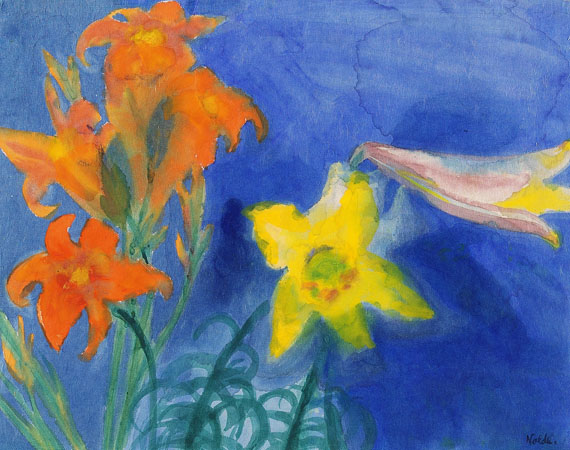Emil Nolde - Lilien (rot und gelb), 1930
EMIL NOLDE
Lilies (red and yellow) . Around 1930.
Watercolor.
Signed lower right. With the former collection stamp of the Nolde Foundation on verso. On Japan 36.5 x 46.1 cm (14.3 x 18.1 in), the full sheet.
With a photo expertise from Dr. Manfred Reuther, Seebüll Ada and Emil Nolde Foundation, dated April 30, 2007
PROVENANCE: Collection of the Nolde Foundation, Seebüll (until 1963).
Joaquín Herrmann, La Paz, Bolivia.
Thomas Herrmann, La Paz, Bolivia.
Ewa Herrmann, La Paz, Bolivia.
Fanny Arroyo de Uria, La Paz, Bolivia.
After studying at Adolf Hölzel's private painting school in Dachau, Emil Nolde switched to the Académie Julian in Paris in 1899. By dealing with the neo-impressionists Vincent van Gogh, Edvard Munch and James Ensor, from 1905 onwards, Nolde went from his initially romantic naturalism to an independent style in which color played an essential role. Color-intensive, luminous flower pictures are created. In 1906, during a stay in Alsen, the artist met the "Brücke" painters, whose group he temporarily joined. The turn to watercolor begins in a series of portrait studies. When Nolde first attempted this technique in 1909 on non-absorbent paper, leaving large parts of the white sheet and dispensing with contouring in the object registration, these innovations are trend-setting. After a controversy with Max Liebermann, Nolde was expelled from the "Berliner Sezession" and founded the "Neue Sezession" in 1910 with other rejected artists, in whose exhibitions he participated until 1912. From 1916 he spent the summer on the island of Föhr and settled in Seebüll in 1928. The garden created there becomes an inexhaustible source of inspiration for his painting.
In Nolde's flower still life from the 1930s, the characteristic of his watercolors is best illustrated: a pictorial freedom that is committed to the subject. The object is always the immovable basis of the design, but is not directly depicted. The motif is limited to hints, the form remains imprecise, the color is used with great freedom in relation to the real object. It spreads beyond the subject's motivic boundaries, overlays and penetrates one another. Motif and painting ground run into one another and create a unity in their color intensity and the blurring of the forms, which does not show the observer the object, but rather refers to it - as a reality that lies outside of the pictorial visible.
In the last years of the artist's life, too, mainly watercolors with flower and landscape motifs were created in the vicinity of the house in Seebüll, where Emil Nolde died on April 13, 1956. [NB]

Comments
Post a Comment